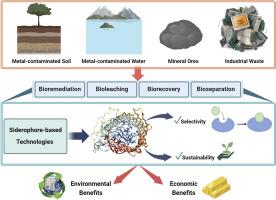基于铁载体的金属生物回收技术的进展
IF 4.8
2区 材料科学
Q1 METALLURGY & METALLURGICAL ENGINEERING
引用次数: 0
摘要
铁载体是一种低分子量的金属螯合生物代谢物,具有高选择性结合铁和其他金属离子的能力。目前已经发现了500多种结构不同的铁载体,为潜在的金属络合提供了不同的配位机制。最近的研究主要在实验室条件下调查了它们在从初级和次级来源(包括矿石、矿山尾矿、电子废物和工业废水)中提取金属方面的应用。这篇综述对各种金属-铁载体系统的研究结果进行了严格的审查,评估了浸出参数、与助溶剂的协同使用以及与混合方法的整合等因素。然而,目前还没有商业应用,而且重大的经济和技术障碍——特别是高生产成本和可扩展性挑战——限制了实际可行性。本综述旨在巩固当前的科学认识,突出现有的局限性,并概述未来现实的研究方向,重点是克服技术和经济限制,以更广泛地实施。本文章由计算机程序翻译,如有差异,请以英文原文为准。

Advancements in siderophore-based technologies for metal biorecovery
Siderophores are low-molecular-weight, metal-chelating biometabolites that exhibit the ability to bind iron and other metal ions with high selectivity. Over 500 structurally distinct siderophores have been identified, offering diverse coordination mechanisms for potential metal complexation. Recent research has investigated their use in extracting metals from both primary and secondary sources, including ores, mine tailings, electronic waste, and industrial effluents—primarily under laboratory conditions. This review critically examines reported findings across various metal–siderophore systems, evaluating factors such as leaching parameters, synergistic use with co-lixiviants, and integration into hybrid approaches. However, no commercial applications currently exist, and significant economic and technical barriers—particularly high production costs and scalability challenges—limit practical viability. This review aims to consolidate current scientific understanding, highlight existing limitations, and outline realistic future research directions focused on overcoming technical and economic constraints to broader implementation.
求助全文
通过发布文献求助,成功后即可免费获取论文全文。
去求助
来源期刊

Hydrometallurgy
工程技术-冶金工程
CiteScore
9.50
自引率
6.40%
发文量
144
审稿时长
3.4 months
期刊介绍:
Hydrometallurgy aims to compile studies on novel processes, process design, chemistry, modelling, control, economics and interfaces between unit operations, and to provide a forum for discussions on case histories and operational difficulties.
Topics covered include: leaching of metal values by chemical reagents or bacterial action at ambient or elevated pressures and temperatures; separation of solids from leach liquors; removal of impurities and recovery of metal values by precipitation, ion exchange, solvent extraction, gaseous reduction, cementation, electro-winning and electro-refining; pre-treatment of ores by roasting or chemical treatments such as halogenation or reduction; recycling of reagents and treatment of effluents.
 求助内容:
求助内容: 应助结果提醒方式:
应助结果提醒方式:


